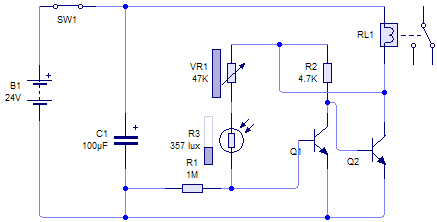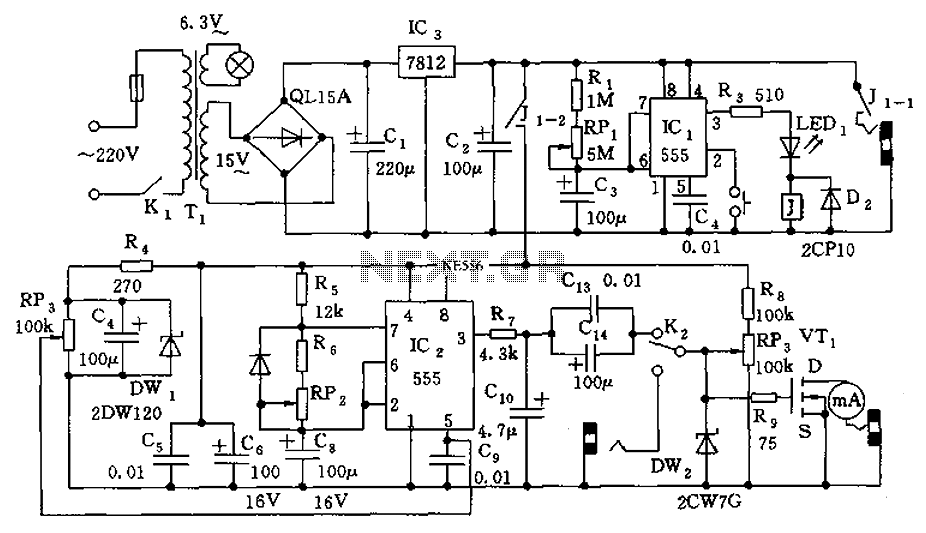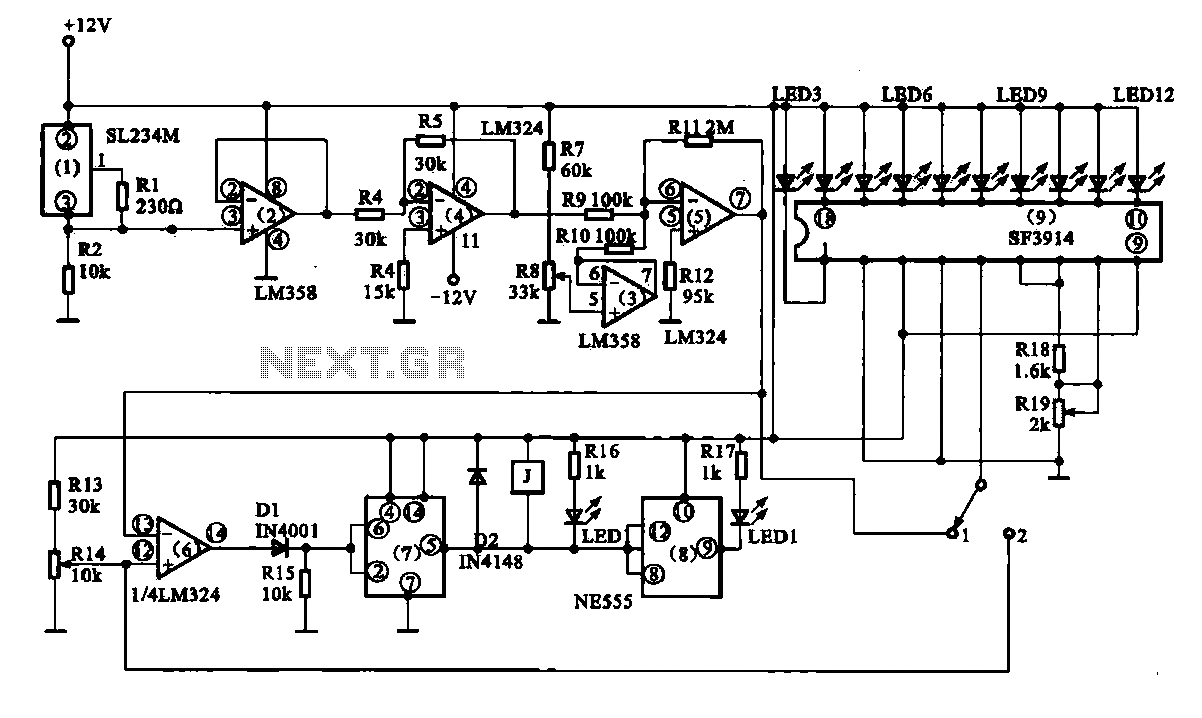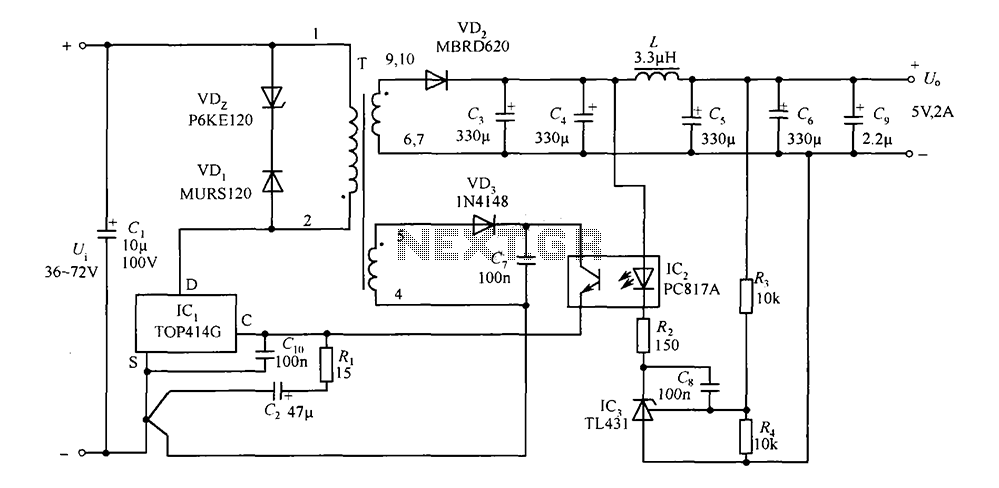
The signal processing circuit

The operation of a semiconductor color sensor can be summarized as follows. The figure illustrates the spectral response curve of two photodiodes that intersect at a specific wavelength. When light of this wavelength is incident on the photodiodes, the currents flowing through both diodes, designated as k and I, are equal. This condition results in a symmetric signal processing circuit where the output voltage (Uo) equals zero. As the incident wavelength increases, the output voltage changes. When the incident wavelength is less than a certain threshold, the output voltage (Uo) is less than zero. This phenomenon is depicted in the figure. In the signal processing circuit, diodes VD3 and VD4 should exhibit identical logarithmic characteristics to effectively compress the photoelectric signal and compensate for the deficiencies in the smaller dynamic range of the motion compensation circuit.
The semiconductor color sensor functions by utilizing two photodiodes that respond to different wavelengths of light. The intersection of their spectral response curves indicates a critical point where the currents through both diodes are equal, leading to a balanced output. This balance is crucial for accurate color detection, as it allows the sensor to determine the intensity of light across various wavelengths.
In the signal processing circuit, the output voltage is a direct representation of the light intensity detected by the photodiodes. When the incident light wavelength is above the intersection point, the output voltage becomes positive, indicating a higher intensity of light. Conversely, if the wavelength is below the intersection point, the output voltage becomes negative, signaling lower light intensity. This behavior is essential for distinguishing between different colors and intensities in various lighting conditions.
Diodes VD3 and VD4 play a significant role in the signal processing circuit. Their logarithmic characteristics are designed to ensure that the output signals are appropriately compressed. This compression is vital for enhancing the sensor's performance, particularly in scenarios where the dynamic range is limited. By matching the characteristics of these diodes, the circuit can effectively process the incoming signals, allowing for accurate color detection and motion compensation.
Overall, the semiconductor color sensor's design and operation rely on the precise interaction between the photodiodes and the signal processing circuit to achieve reliable performance in color sensing applications. The careful consideration of component characteristics and circuit design ensures that the sensor can operate effectively across a range of conditions, providing accurate and consistent results.It works semiconductor color sensor can be summarized as follows. The figure shows the spectral response curve of two photodiodes have a point of intersection, when the wavelength of the light incident on the corresponding intersection, flow through both diodes current k- ostrich and I are equal, since symmetry A signal processing circuit 7-23 resistance, output voltage Uo = o. When the incident grew up in the ^. When, by the FIG know, Isu Ia-i. The output voltage Uo 0} when the incident wavelength less than ^. When the output voltage Up <o. This is illustrated in FIG. In the signal processing circuit, the diode VD3 and VD4 should have the same logarithmic characteristic j, respectively, to achieve the number of photoelectric signal compression, motion compensating circuit smaller dynamic range deficiencies.
The semiconductor color sensor functions by utilizing two photodiodes that respond to different wavelengths of light. The intersection of their spectral response curves indicates a critical point where the currents through both diodes are equal, leading to a balanced output. This balance is crucial for accurate color detection, as it allows the sensor to determine the intensity of light across various wavelengths.
In the signal processing circuit, the output voltage is a direct representation of the light intensity detected by the photodiodes. When the incident light wavelength is above the intersection point, the output voltage becomes positive, indicating a higher intensity of light. Conversely, if the wavelength is below the intersection point, the output voltage becomes negative, signaling lower light intensity. This behavior is essential for distinguishing between different colors and intensities in various lighting conditions.
Diodes VD3 and VD4 play a significant role in the signal processing circuit. Their logarithmic characteristics are designed to ensure that the output signals are appropriately compressed. This compression is vital for enhancing the sensor's performance, particularly in scenarios where the dynamic range is limited. By matching the characteristics of these diodes, the circuit can effectively process the incoming signals, allowing for accurate color detection and motion compensation.
Overall, the semiconductor color sensor's design and operation rely on the precise interaction between the photodiodes and the signal processing circuit to achieve reliable performance in color sensing applications. The careful consideration of component characteristics and circuit design ensures that the sensor can operate effectively across a range of conditions, providing accurate and consistent results.It works semiconductor color sensor can be summarized as follows. The figure shows the spectral response curve of two photodiodes have a point of intersection, when the wavelength of the light incident on the corresponding intersection, flow through both diodes current k- ostrich and I are equal, since symmetry A signal processing circuit 7-23 resistance, output voltage Uo = o. When the incident grew up in the ^. When, by the FIG know, Isu Ia-i. The output voltage Uo 0} when the incident wavelength less than ^. When the output voltage Up <o. This is illustrated in FIG. In the signal processing circuit, the diode VD3 and VD4 should have the same logarithmic characteristic j, respectively, to achieve the number of photoelectric signal compression, motion compensating circuit smaller dynamic range deficiencies.





